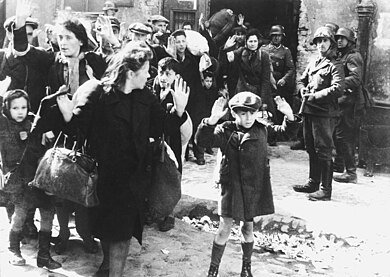This article has an unclear citation style. (November 2019) |
 Warsaw Ghetto boy, perhaps the most iconic photograph representing children in the Holocaust |
During the Holocaust, children were especially vulnerable to death under the Nazi regime. An estimated 1.5 million children,[1] nearly all Jewish, were murdered during the Holocaust, either directly by or as a direct consequence of Nazi actions.
The Nazis advocated killing children of unwanted or "dangerous" people in accordance with their ideological views, either as part of the Nazi idea of the racial struggle or as a measure of preventive security. They particularly targeted Jewish children, but also targeted ethnically Polish children and Romani (also called Gypsy) children and children with mental or physical disabilities. The Nazis and their collaborators killed children for these ideological reasons and in retaliation for real or alleged partisan attacks.[2] Early killings were encouraged by the Nazis in Aktion T4, where children with disabilities were gassed using carbon monoxide, starved to death, given phenol injections to the heart, or hanged.
A much smaller number were saved. Some simply survived, often in a ghetto, occasionally in a concentration camp. Some were saved in various programs like the Kindertransport and the One Thousand Children, in both of which children fled their homelands. Other children were saved by becoming Hidden Children. During and even before the war, many vulnerable children were rescued by Œuvre de Secours aux Enfants (OSE).
- ^ "Children during the Holocaust". encyclopedia.ushmm.org. Retrieved 12 October 2024.
- ^ "CHILDREN DURING THE HOLOCAUST". United states Holocaust Memorial Museum. 1 October 2019. Retrieved 30 March 2021.